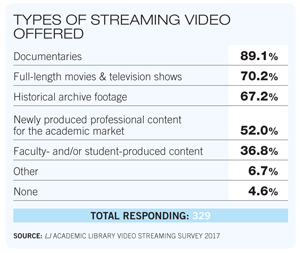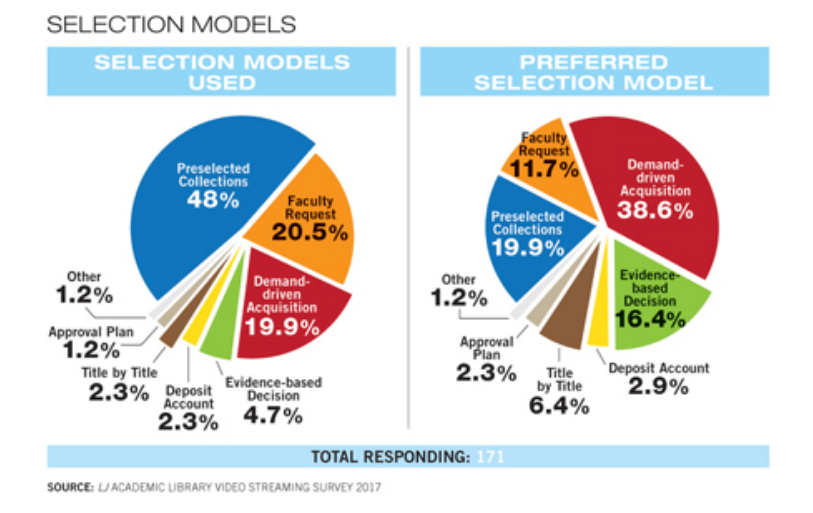Every two years, the ACRL Research Planning and Review Committee publishes in College & Research Libraries News an article on the top trends and issues affecting academic libraries and the change our institutions are experiencing. We will be highlighting some of these trends through a number of blog posts over the next few weeks.
In a world in which technology is advancing more rapidly than ever before, streaming media – media that is presented to users in real time as they need or desire to use it – has become especially pervasive. Streaming services are one of the key ways in which we watch television; listen to music; and access lectures, live theater performances and other internet resources for research and entertainment purposes. From Netflix to Hulu, subscription numbers continue to rise. This was the case even before the COVID-19 pandemic kept many people at home.

Educators have long known that images and audio provide information that is not always apparent through the written word and that students have different learning styles. For example, some are visual learners and are best able to process and retain information that is conveyed in images. For that reason, we have seen teachers at all levels incorporating visual content into the curriculum to complement assigned texts.
As librarians and information professionals, it is our responsibility to note these changes and see how we can apply them to best serve our patrons. So it should come as little surprise that libraries too have started subscribing to streaming services.
Just as individuals weigh factors in deciding which and how many of the ever growing and competitive offerings they will select – Disney+, Sling, Amazon Prime, Curiosity Stream, Peacock, Criterion Channel, Apple – librarians take several factors into consideration when choosing the streaming services available to libraries. These factors include: content, ease of use and accessibility, and budgeting terms and costs.

Content
For librarians, the process of selecting streaming services is not as simple as subscribing to a favorite platform with your favorite sitcoms. There are other factors to consider. Are there streaming services that cater to an especially large group of students on campus engaged in similar kinds of research? Will the instructors be showing these films in the classroom? Does the streaming service limit its offerings to education films? Is there also demand for popular films, film classics, television programs, recent mainstream movies, documentaries, animated films, concerts, and/or foreign-language films? If so, which service has the content most requested by the university community? Does the service include features such as captions and the ability to select and save a film clip?
Ease of Use and Accessibility
Librarians have also seen the usefulness of subscribing to streaming media services because it allows them to meet students wherever they are, whether or not those students are coming onto campus to take classes. Many students had taken advantage of options for online education before the beginning of the COVID-19 pandemic. Classes offered for students enrolled in online (and in-person) programs might require accessing films for reading or research purposes. Academic librarians must pay careful attention to what kinds of classes are being offered, just as they do when choosing print materials commonly used in courses offered at their university.
During the recent pandemic, faculty in particular have faced significant challenges in providing resources for their students while teaching them virtually. One benefit of streaming services is that even if library staff are unable to work onsite and provide access to scans of library print materials for classroom use, reference librarians can point professors to streaming services accessible through library databases. Given this increased need to consider the preferences of faculty and other users while library service remains limited, patron input will continue to be invaluable for librarians even after they can once again access physical library materials.

One final trend to note is the recent need for librarians to consider access by the entire college or university community when choosing streaming media. The goal is to find resources that allow students with disabilities equal access. When it comes time for librarians to consider which subscriptions to renew, they will increasingly consider how resources measure up to the accessibility standards put in place by the library and the university (Schroeder 2018, 401). Issues related to accessibility include small print; limited voice output or recognition; and PDF documents that are not formatted to be compliant with updated standards (Schroeder 2018, 405, 409). As is made clear from this case study, it is now required that many librarians will be familiar with issues of accessibility and able to offer support to students needing accessible resources.
Budgeting Terms and Costs
Budgetary constraints also restrict the kinds of streaming services that academic libraries can provide. When libraries provide students and faculty with access to streaming services, it is generally because they have worked with vendors to obtain a license for particular groups of films, documentaries, recordings, etc. These licenses guarantee a price for only a certain amount of time, and changes in price and content require acquisitions librarians to revisit existing subscriptions frequently. They must remain aware of copyright agreements and competing interests among streaming service providers in order to ensure that those services continue to provide access to a specific set of resources. In some instances, patron-driven models – which require payment based upon students’ use of electronic materials – become too expensive for libraries. Because of these considerations, streaming services must be evaluated in light of the library’s collection development policies: the policies libraries use to guide their decision-making when acquiring new materials (Wahl, 2017). Ensuring that license agreements comply with copyright regulations can also occupy librarians’ time.
Another way to highlight the unique challenges libraries face in deciding between streaming media services is to differentiate between institutional and individual subscriptions. Students and faculty are aware of the monthly standardized fees that they pay for their own personal subscriptions. However, they are unlikely to be aware of the financial strain that subscriptions at the institutional level can cause: the streaming services simply become another “free” service provided by the library. Chris Cagle acknowledges this in his article published in Film Quarterly. He explains that students probably have little idea that their use of streaming materials can have this kind of impact on a library’s budget. While librarians choose streaming services that provide access to a wide range of resources, these streaming services can become out of reach if they require that libraries pay according to frequency of patron use. Recognizing that no service can provide access to everything, librarians might begin choosing less expensive subscriptions to services that have comparatively limited access rather than services such as Kanopy that offer extensive access at a potentially crippling cost.
Services at Catholic University Libraries
The Catholic University Libraries subscribe to a variety of streaming services, including audio and video (for a complete list, click here). Two of our latest additions are Quest TV, a service offering access to concerts and documentaries, through September 30th of next year, and On the Boards TV, a portal for viewing performance films of ground-breaking artistic projects in dance, theater, music, and experimental forms. Look beyond HBO Max…you might be surprised what you find!
Additional Reading
Dunn, Cathy. 2020. “Streaming Video Acquisitions: Factors to Consider.” Journal of Electronic Resources Librarianship 32, no. 2: 133-135.
Lowe, Randall A., et. al. 2020. “Managing Streaming Video: The Experiences of Six Academic Libraries.” Journal of Electronic Services Librarianship 32, no. 2: 119-126.
Rodgers, Andrea. 2019. “Once upon a Time in Streaming Video: A Community College’s Adventure with Kanopy’s PDA Model,” College & Research Libraries News 80, no. 9. https://crln.acrl.org/index.php/crlnews/article/view/23578/30892
Schroeder, Heidi M. 2018. “Implementing Accessibility Initiatives at the Michigan State University Archives.” Reference Services Review 46, no. 3: 399-413.
Wahl, Mary. 2017. “Full Steam Ahead: Designing a Collection Development Workflow for Streaming Video Content.” Library Resources and Technical Services 61, no. 4. https://journals.ala.org/index.php/lrts/article/view/6471/8573
Wang, Jian, and Elsa Loftis. 2020. “The Library Has Infinite Streaming Content, But Are Users Infinitely Content? The Library Catalog vs. Vendor Platform Discovery.” Journal of Electronic Resources Librarianship 32, no. 2: 71-86.
